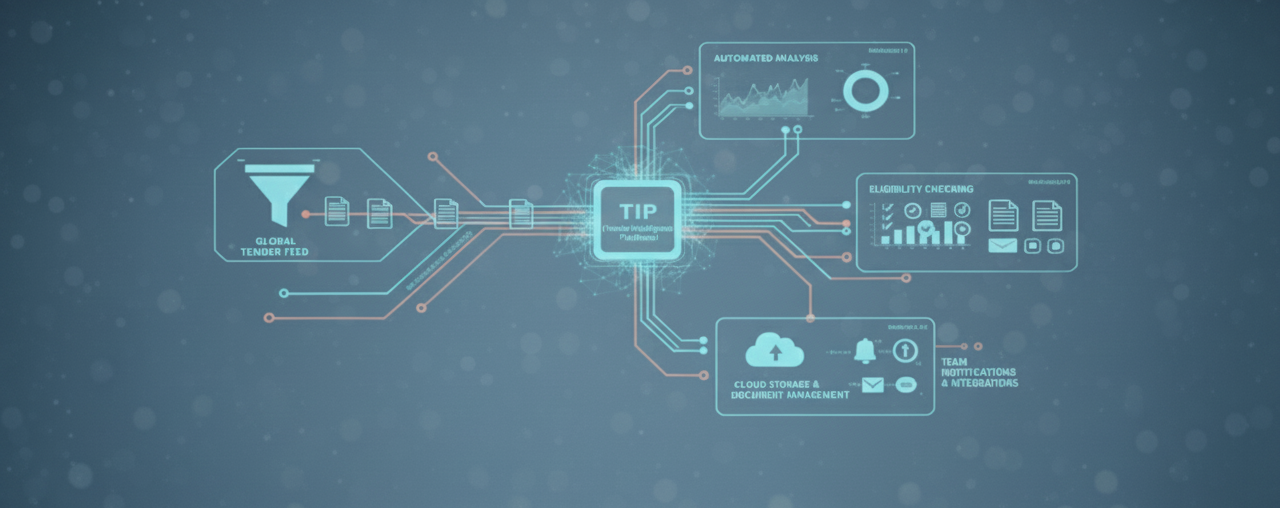Automating Opportunity: A Deep Dive into the Tender Intelligence Platform
We are excited to unveil Our new project—The Tender Intelligence Platform. AI-powered system that automates the entire tender lifecycle—from discovery and analysis to reporting and cloud storage
In the fast-paced world of business development, speed and accuracy are paramount. Manually sifting through hundreds of tender opportunities is a time-consuming, error-prone process that can lead to missed deadlines and lost revenue. To address this challenge, we developed the Tender Intelligence Platform, a comprehensive, AI-powered system that automates the entire tender lifecycle—from discovery and analysis to reporting and cloud storage.
The Core Mission
The goal was to create a system that could:
- Automate the discovery and analysis of new tenders
- Drastically reduce manual effort and the potential for human error.
- Provide a centralized, organized system for tender documents.
- Empower business teams to make faster, data-driven decisions.
- Seamlessly integrate with modern cloud storage and team notification platform.
The Architecture and Technology Stack
The platform is built on a modern, modular architecture designed for scalability and reliability. Each component in the pipeline is a distinct service responsible for a specific task, ensuring maintainability and robust performance.
Technology Stack:
- Language: Python 3.8+
- Web Automation: Playwright
- Data Processing: Pandas, Numpy
- ML Framwork: PyTorch, Sentence Transformers
- PDF Generation: ReportLab
- Cloud integration: AWS S3, Google Drive
- Authentication: OAuth 2.0, AWS Secrets Manager
A Journey Through the 10-Phase Pipeline
The platform operates via a multi-phase pipeline that handles every step of the process automatically
Phase 1: Authentication & Setup
The process begins with secure authentication. The system uses Playwright for browser automation to log into the Tiger Tender portal, handling anti-detection measures like user agent rotation. Credentials are not hard-coded; they are retrieved securely from AWS Secrets Manager. Session cookies are stored to maintain the session and minimize logins
Phase 2: Tender discovery
Once authenticated, the TenderAPIService queries the Tiger Tender API to discover new tenders based on configurable criteria like date ranges. To avoid being blocked, the service implements smart rate limiting and an exponential backoff retry mechanism for failed requests
Phase 3: Tender Summary Fetching
For each tender discovered, the TenderSummaryService fetches a detailed summary. This module is responsible for parsing and normalizing the data, ensuring that incomplete or missing fields are handled gracefully before passing structured data downstream
Phase 4: AI-Powered Analysis
This is where the intelligence of the platform shines. The TenderAnalysisService uses a Sentence Transformer model ( all-MiniLM-L6-v2 ) to analyze tender descriptions and score their relevance against the company's profile. It performs multi-layered filtering based on keywords, budget, location, and client type to identify the most promising opportunities.
Phase 5: The Business Rules Engine
After the initial AI analysis, the BusinessRulesEngine applies a set of configurable, company-specific rules. This engine evaluates tenders against precise criteria, such as:
- 💰Budget: A tender's value must fall within a preferred range (e.g., ₹5 Lakhs to ₹5 Crores)
- 📍Location: Preference is given to tenders in metro cities, which receive a higher score multiplier
- 🧑💼Experience: The system checks if the company meets the minimum experience required by the tender
For all qualified tenders, the DocumentDownloadService initiates parallel downloads of all associated documents. It features progress tracking, file validation to ensure integrity, and format conversion capabilities.
Phase 7: Automated Report Generation
Manually creating summaries is tedious. The JSONToPDFConverter module uses ReportLab to automatically generate two key documents for each qualified tender:
- 📝Tender Summary PDF:A clean, professinal report detailing the tender's scope, financials ans technical requirements
- ☑️Qualification Checklist PDF: An actionable checklist of eligibility criteria and required documents.
To facilitate team collaboration, the DriveUploadService uploads the generated PDFs and all original tender documents to a shared Google Drive folder. The files are organized into a clean, hierarchical structure for easy access:
- Tiger Tinder/
- YYYY-MM-DD/
- Tender_[ID]/
- summary.pdf
- checklist.pdf
- doucments/
For long-term storage and data integrity, the S3Service backs up all raw and processed data to an AWS S3 bucket. The data is organized by date, ensuring a complete and auditable record of the pipeline's daily activities. The platform uses AWS S3 Server-Side Encryption (AES-256) to protect data at rest
Phase 10: Notifications & Cleanup
Finally, the system sends real-time status updates and summary reports to a designated Slack channel, keeping the team informed of newly discovered tenders and any potential issues. The pipeline concludes with a cleanup phase that removes temporary local files and prepares for the next run.
Why It Matters?
The Tender Intelligence Platform transforms a manual, labor-intensive process into a streamlined, automated workflow. The key business benefits include:
- ⚡Unmatched Efficiency: Automating the entire pipeline saves hundreds of hours of manual work, freeing up teams to focus on strategic tasks like bid preparation
- 🎯Enchanced Accuracy: The system eliminates human error, ensuring that no tender is overlooked and that all data is processed consistently according to predefined rules
- ♟️Data-Driven Strategy: By scoring and prioritizing tenders, the platform enables business development teams to focus their efforts on the highest-value opportunities first.
- 🔒Scalability & Security: Built with multi-tenancy support, the platform can serve multiple clients with isolated configurations. Credentials and data are secured using industry best practices like AWS Secrets Manager and encryption
How We've Evolved: From a Tool to an Intelligent Pipeline



